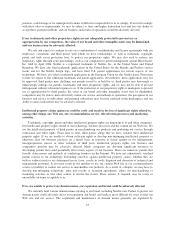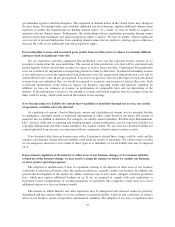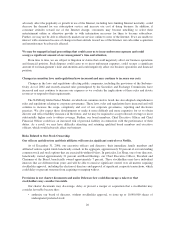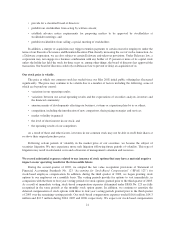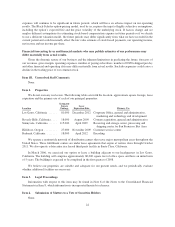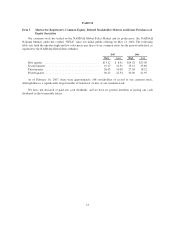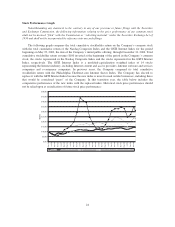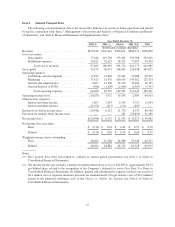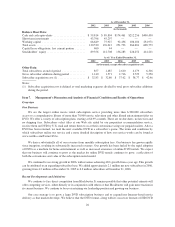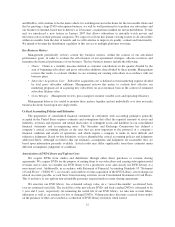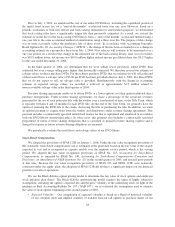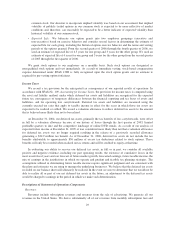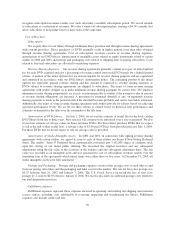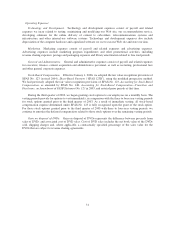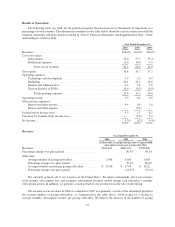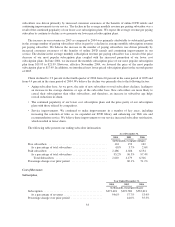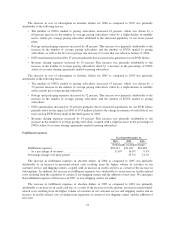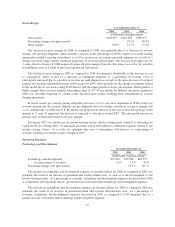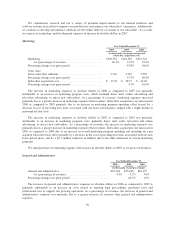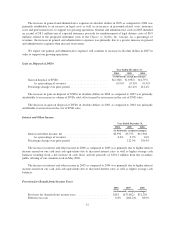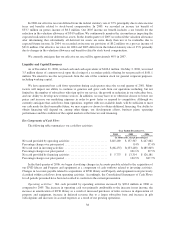NetFlix 2006 Annual Report Download - page 36
Download and view the complete annual report
Please find page 36 of the 2006 NetFlix annual report below. You can navigate through the pages in the report by either clicking on the pages listed below, or by using the keyword search tool below to find specific information within the annual report.Prior to July 1, 2004, we amortized the cost of our entire DVD library, including the capitalized portion of
the initial fixed license fee, on a “sum-of-the-months” accelerated basis over one year. However, based on a
periodic evaluation of both new release and back-catalog utilization for amortization purposes, we determined
that back-catalog titles have a significantly longer life than previously estimated. As a result, we revised the
estimate of useful life for the back-catalog DVD library from a “sum of the months” accelerated method using a
one year life to the same accelerated method of amortization using a three-year life. The purpose of this change
was to more accurately reflect the productive life of these assets. In accordance with Accounting Principles
Board Opinion No. 20, Accounting Changes (“APB 20”), the change in life has been accounted for as a change in
accounting estimate on a prospective basis from July 1, 2004. New releases will continue to be amortized over a
one year period. As a result of the change in the estimated life of the back-catalog library, total cost of revenues
was $10.9 million lower, net income was $10.9 million higher and net income per diluted share was $0.17 higher
for the year ended December 31, 2004.
In the third quarter of 2004, we determined that we were selling fewer previously rented DVDs than
estimated but at an average selling price higher than historically estimated. We therefore revised our estimate of
salvage values on direct purchase DVDs. For those direct purchase DVDs that we estimate we will sell at the end
of their useful lives, a salvage value of $3.00 per DVD has been provided effective July 1, 2004. For those DVDs
that we do not expect to sell, no salvage value is provided. Simultaneously with the change in accounting
estimate of expected salvage values, we recorded a write-off of approximately $1.9 million related to
non-recoverable salvage value in the third quarter of 2004.
Revenue sharing agreements enable us to obtain DVDs at a lower upfront cost than under traditional direct
purchase arrangements. Under revenue sharing agreements, we share a percentage of the actual net revenues
generated by the use of each particular title with the studios over a fixed period of time, or the Title Term, which
is typically between 6 and 12 months for each DVD title. At the end of the Title Term, we generally have the
option of returning the DVD title to the studio, destroying the title or purchasing the title. In addition, we remit
an upfront payment to acquire titles from the studios and distributors under revenue sharing agreements. This
payment includes a contractually specified initial fixed license fee that is capitalized and amortized in accordance
with our DVD library amortization policy. In some cases, this payment also includes a contractually specified
prepayment of future revenue sharing obligations that is classified as prepaid revenue sharing expense and is
charged to expense as future revenue sharing obligations are incurred.
We periodically evaluate the useful lives and salvage values of our DVD library.
Stock-Based Compensation
We adopted the provisions of SFAS 123R on January 1, 2006. Under the fair value recognition provisions of
this statement, stock-based compensation cost is estimated at the grant date based on the fair value of the awards
expected to vest and is recognized as expense ratably over the requisite service period, which is the vesting
period. We adopted the fair value recognition provisions of SFAS No. 123, Accounting for Stock-Based
Compensation, as amended by SFAS No. 148, Accounting for Stock-Based Compensation—Transition and
Disclosure, an Amendment of FASB Statement No. 123 in the second quarter of 2003, and restated prior periods
at that time. Because the fair value recognition provisions of SFAS 123 and SFAS 123R were materially
consistent under our equity plans, the adoption of SFAS 123R did not have a significant impact on our financial
position or results of operations.
We use the Black-Scholes option pricing model to determine the fair value of stock options and employee
stock purchase plan shares. The Black-Scholes option-pricing model requires the input of highly subjective
assumptions, including the option’s expected life and the price volatility of the underlying stock. In light of the
guidance in Staff Accounting Bulletin No. 107 (“SAB 107”), we re-evaluated the assumptions used to estimate
the value of stock options beginning in the second quarter of 2005.
•Expected Volatility: Our computation of expected volatility is based on a blend of historical volatility
of our common stock and implied volatility of tradable forward call options to purchase shares of our
28


